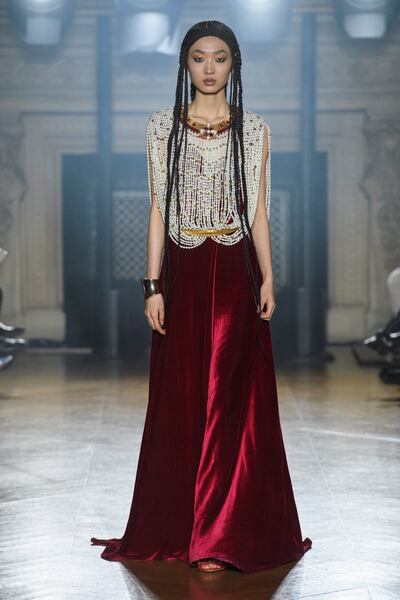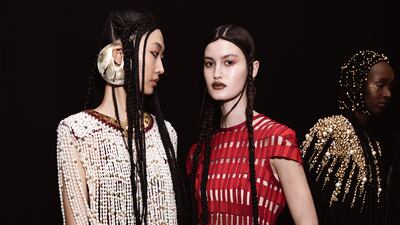“Our lives are about what we can give, what we can share, and how we can make people feel beautiful and happy in themselves,” says Moroccan couturier Sara Chraibi.
The designer takes pleasure in gathering people around her, whether to create a fashion collection, stage a catwalk show or simply share food and music. All these actions contribute to a sense of love, community and common purpose.
That belief in sharing, of team effort, came to fruition on the catwalk at the historic Theatre du Chatelet in Paris in January, when Chraibi made her debut as a guest on the Paris haute couture calendar. She describes it as a milestone, having founded Maison Sara Chraibi in Paris in 2011, relocating it to her home city of Rabat in 2014.

“An haute couture show is something I’ve wanted to do since I began my journey in fashion,” says Chraibi a few weeks later over a video call from Rabat, where she is preparing for a trip to New York. “I had been expecting it to be a big rush [backstage], but I was very calm and very focused, and I don’t know why.
“It was very emotional and I am grateful to the 100 people who helped make it happen. It was a huge team, with hair, make-up, models, production all working towards the same goal.”
Drawing on her early training as an architect and a childhood love of embroidery learnt from the women in her family, Chraibi, now 40, wove strands of her personal history into the collection, called L’Etoffe des Songes, or The Fabric of Dreams. Her long fluid dresses, tunics, crop tops and trouser ensembles fused her love of structure with the ornate artistry of her Moroccan heritage. However, while drawing on the traditional artisanal craftsmanship of her country, the results were modern and sophisticated, and radiated a mystical allure.
“The structure of the garment is very important to me as an architect and I always think of the garment as a creative gesture,” she says. “I don’t want ornamentation to be the main subject.”
Her dresses have fluidity, but are overlaid with an architecture-inspired framework of interwoven black cord and gilded ribbon cages using traditional weaving techniques such as sfifa (a type of ribbon braid) for their construction.

It’s a decidedly untraditional way of using sfifa, she points out, emphasising that while it employs artisanal skills, her vision is very modern. This is seen in cleanly tailored navy and white coats that dissolve into beaded skirts with fringes. Or a cage top of gold ribbon and black corded strands of sabra, a form of silk made from the aloe vera plant traditionally used in Moroccan passementerie, which unravel into long tassels that brush the floor. Meanwhile, gold embroidered stars shimmer on gowns and tuxedos.
Chraibi is authentic to her roots but suffuses it with a cool contemporary glamour. She says she was delighted with the feedback to her show. “We often see craftsmanship as something old and not fashionable and what they [press and clients] saw in my vision was a new concept, a fresh way to work with ancient techniques.

“A vision of Morocco, but seen as something both very contemporary and very rooted. It’s infused with Moroccan craftsmanship, but really I take a lot of liberties with that,” she admits unapologetically.
The couturier, who has clients in Morocco, the UAE, Qatar and, more recently, Kuwait and Saudi Arabia, and includes Moroccan singers Manal and Asma Lmnawar and French-Moroccan actress Ouidad Elma among her fans, was thrilled to be back in Paris, where she spent 10 years of her life. Raised in a cultural and artistic environment, she studied architecture in Rabat and then in Paris, where she graduated in philosophy and architectural theory. However, it was here that she realised her love of fashion and her journey as a couturier began.

Kaftans are deeply ingrained in her culture, and Chraibi remembers her grandmother wearing embroidered ones every day, not solely for ceremonies and special occasions. Nevertheless, there were only a couple of dresses in Chraibi’s collection seemingly inspired by this traditional dress.
“I don’t consider myself as solely a kaftan designer, I consider myself a designer who also does kaftans for the local market. I do not want to be pigeonholed. The kaftan is part of my path as a designer and important in my culture, and so when I returned to Rabat, I realised I had to find my own way with it,” she says, admitting she takes liberties with reinventing the design as an act of reconciliation with her culture. “I need to offer a new vision with contemporary craftsmanship and not leave it as it is.”
Her team in Rabat are all female, bar one man who is a cutter. “This feminine energy is very important to me,” she says. “I want to empower people with my work. Yes, it’s about creating and fashion, but it’s also about being together and team success, and I am very grateful to them.”
She describes them as “a sorority of brave women I’m happy to call my family”. Many are gifted embroiderers who are not using their skills in a traditional way, but instead modernising them. As an example, a rich red velvet dress with a bodice of draped rows of pearls is inspired by Moroccan brides, who wear lots of pearls. But the designer wanted to give it a fresh interpretation and, at the same time, make it an heirloom piece. The idea of transmission between generations and sharing of legacy is something very important in her work.
Chraibi talks about celebrating women, matriarchy and the beauty of unity in her creations. The feeling of family and togetherness is at the heart of her philosophy. She describes it as the art of living. Her family are musical, and gatherings invariably end up with her mother singing and her father playing the oud, with everyone else joining in. She loves cooking not so much for making dishes, but for bringing family and friends together.
“It means a lot to me to be with people singing and eating,” she says. “I believe food, to a certain point, is a love language.” She visualises couture in the same way — as an act of giving and “sharing in a special moment with a client and making them happy”.

